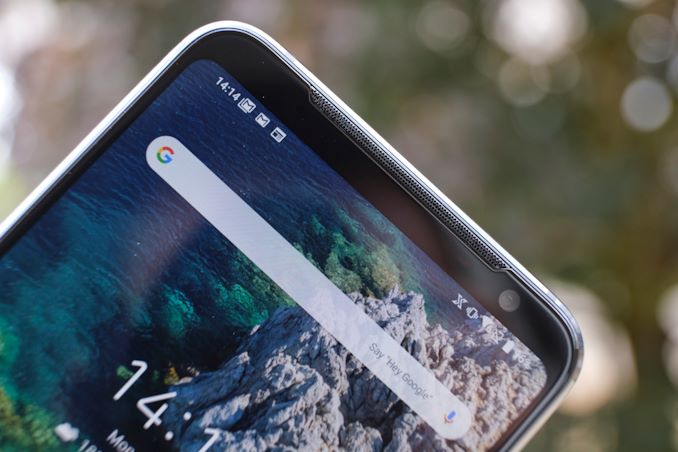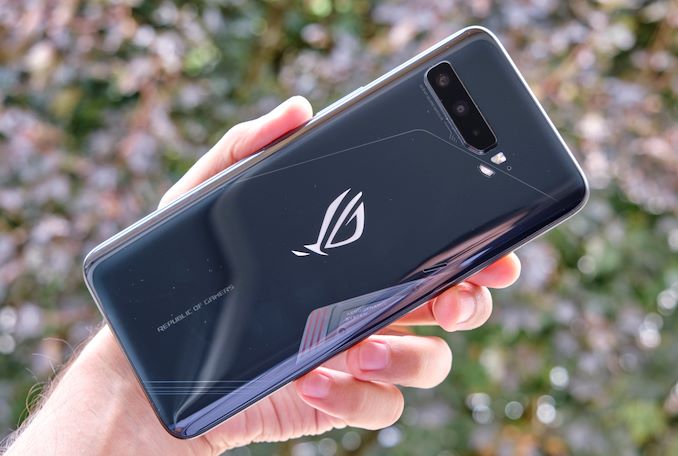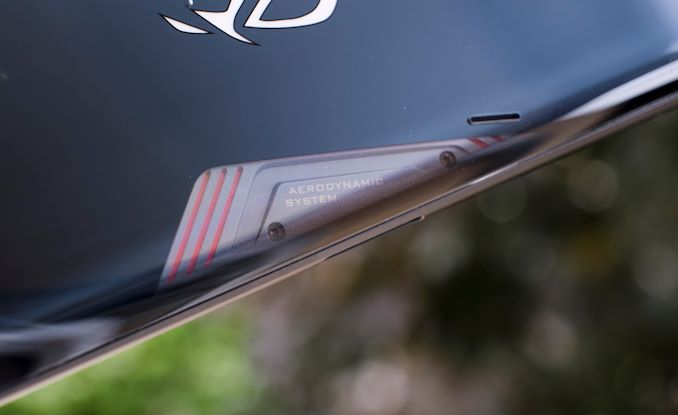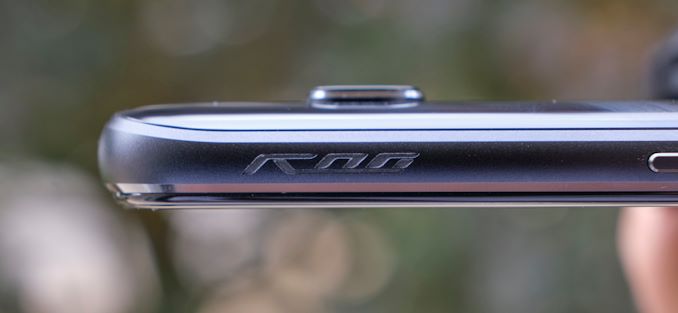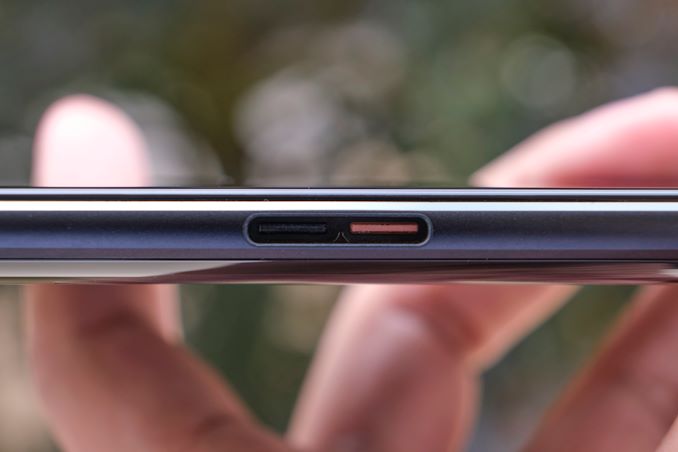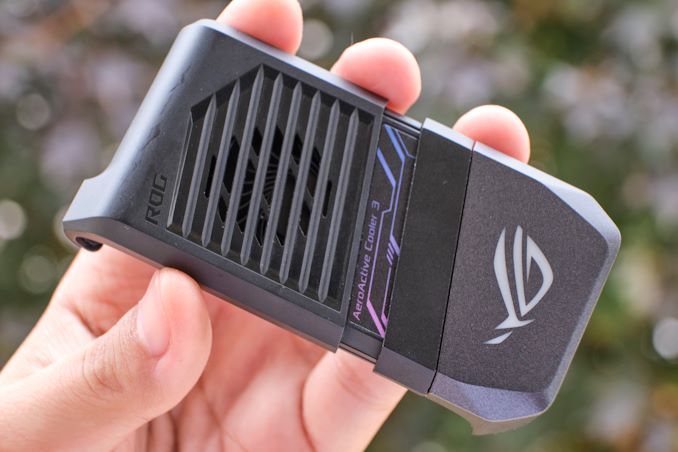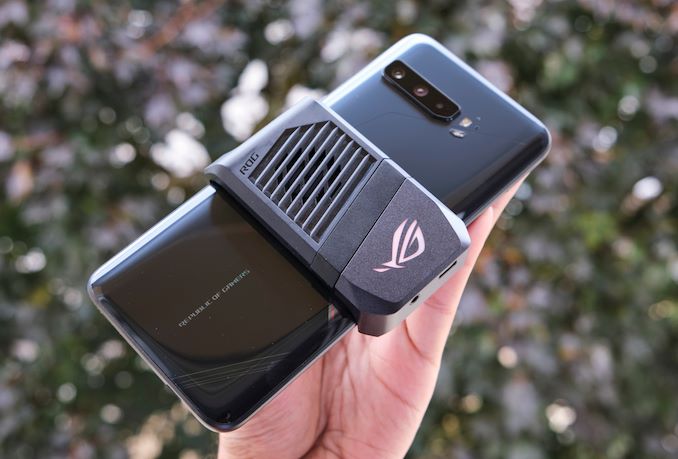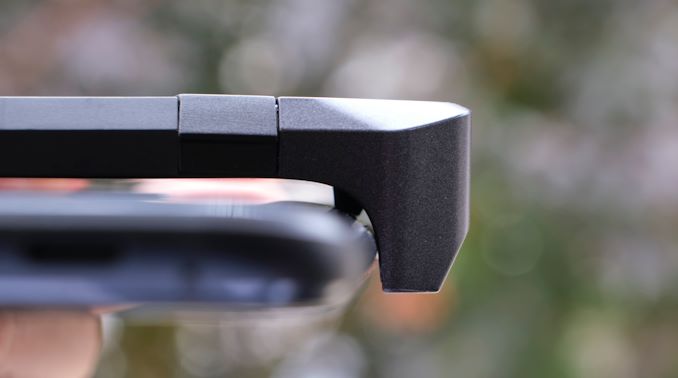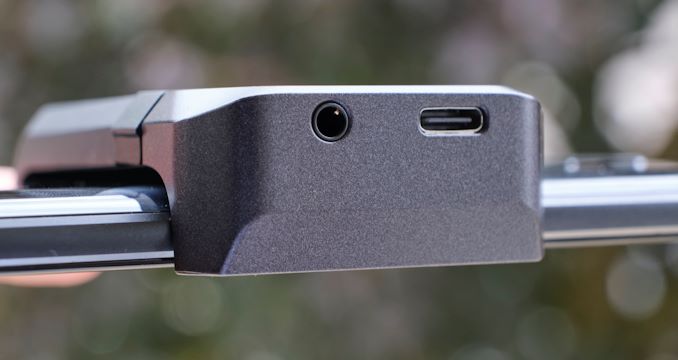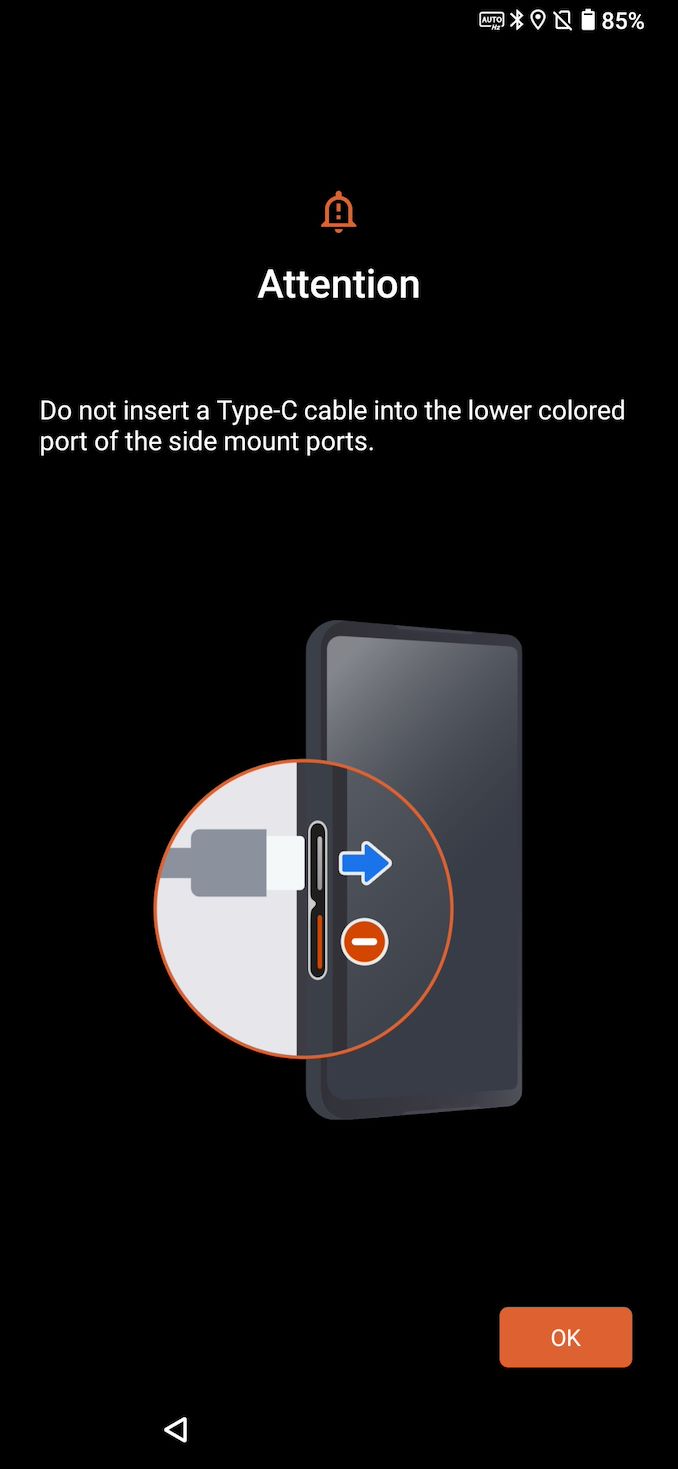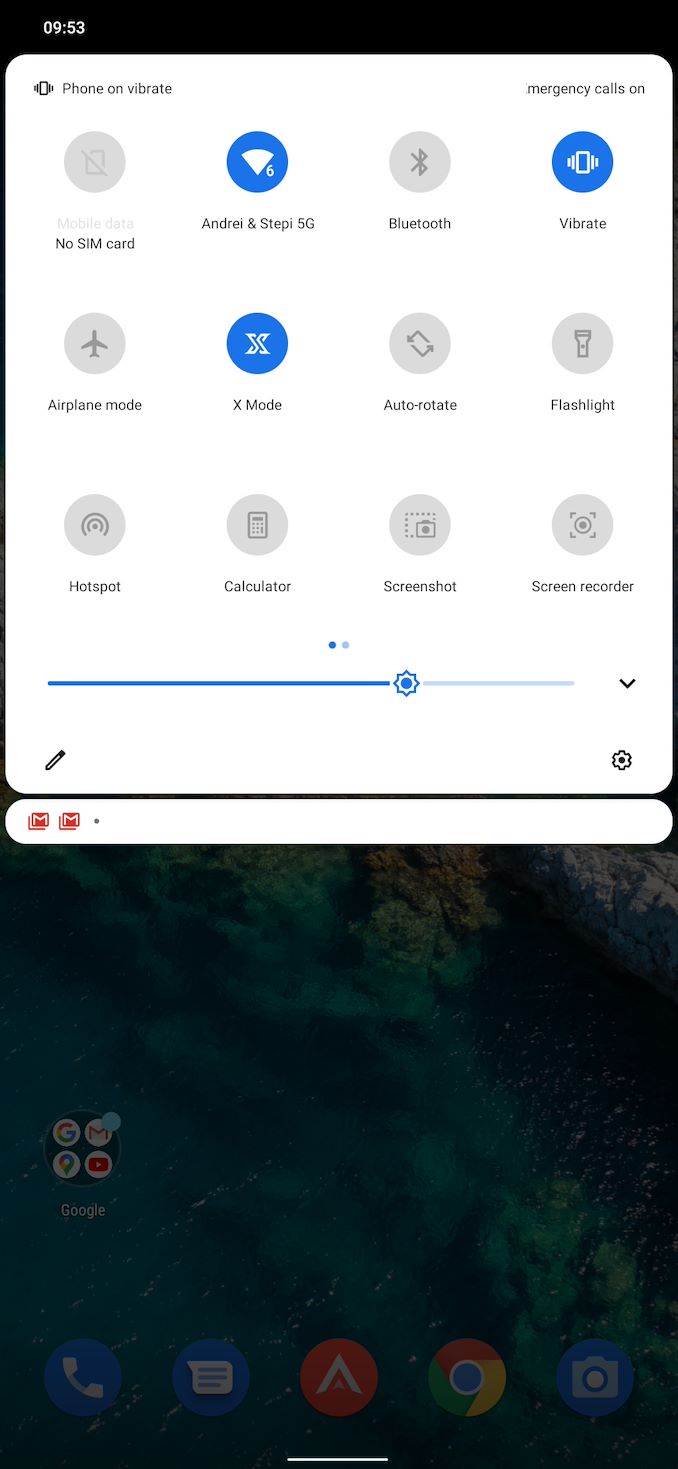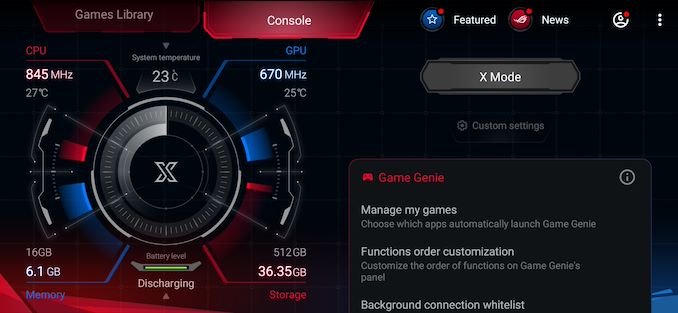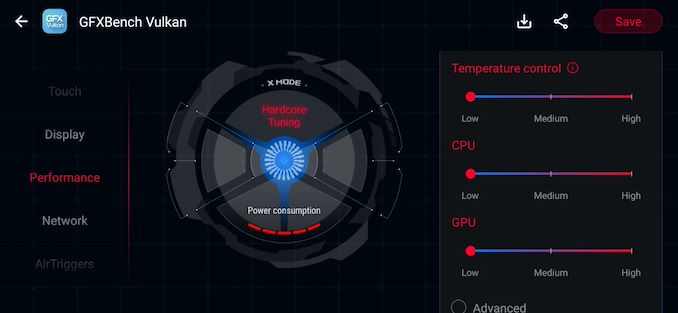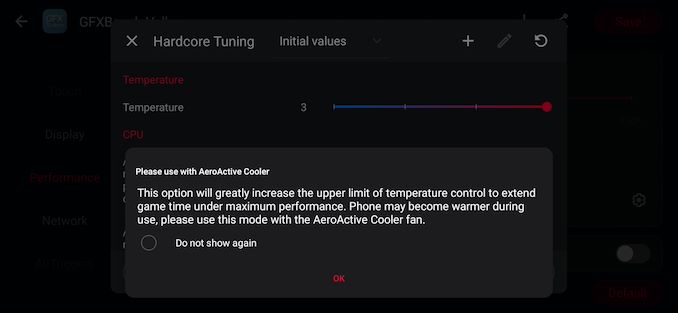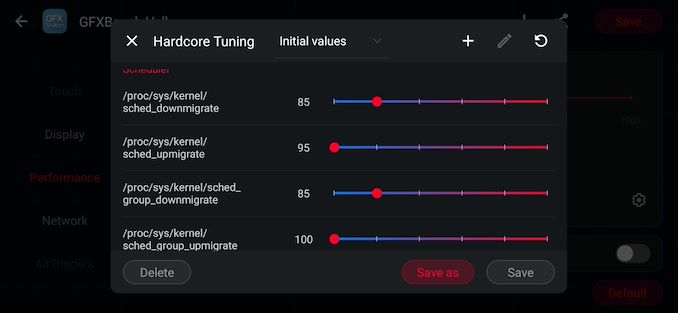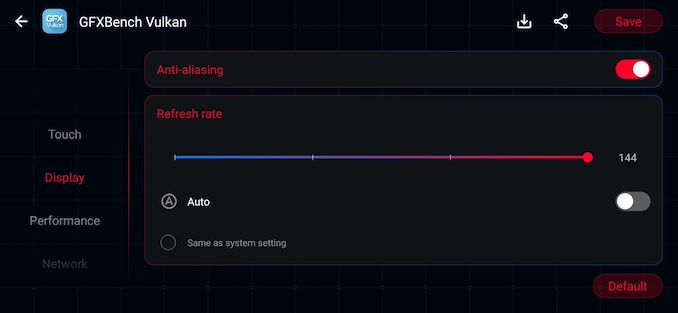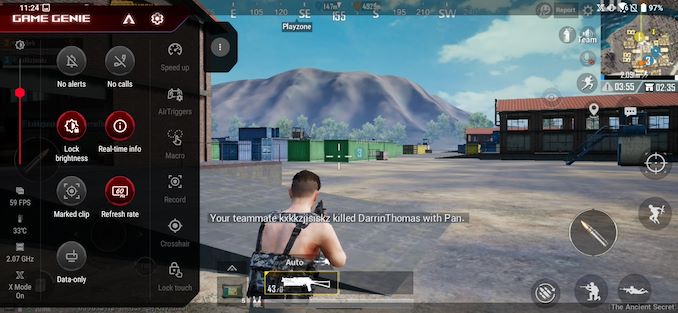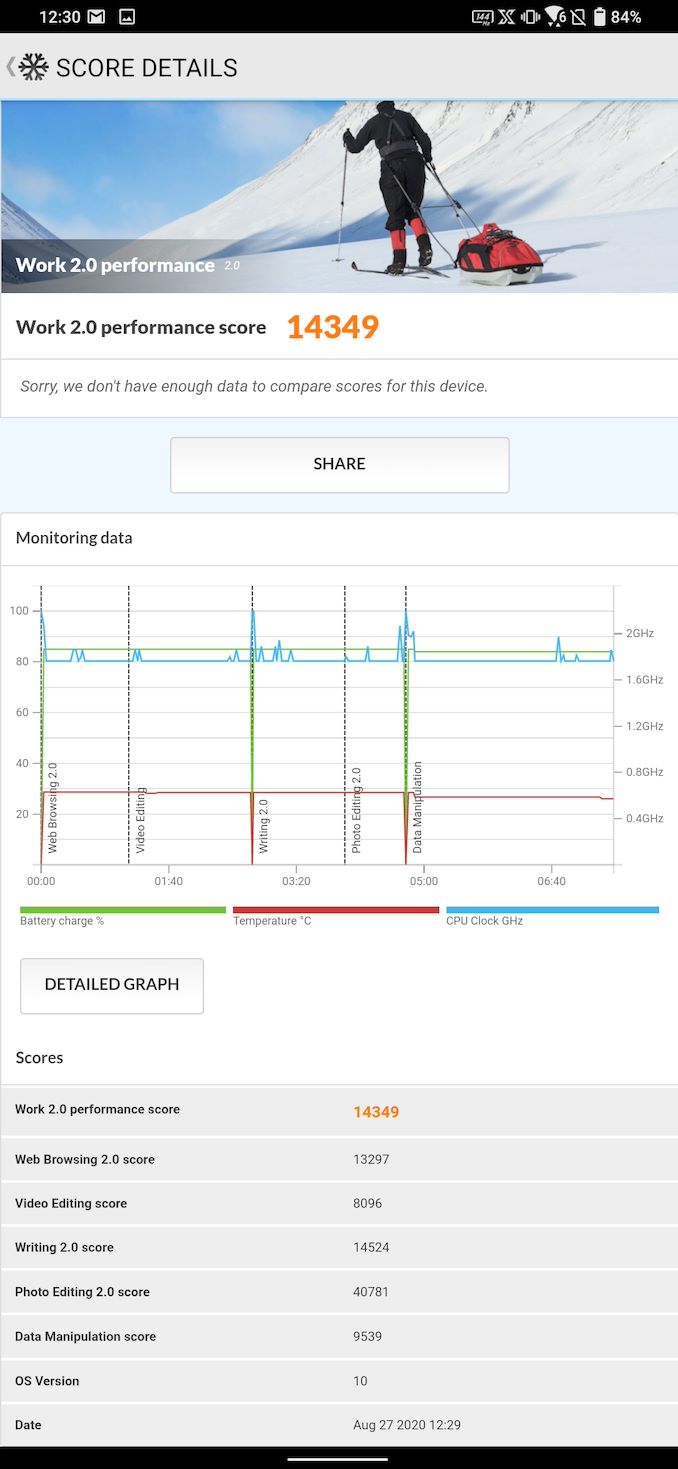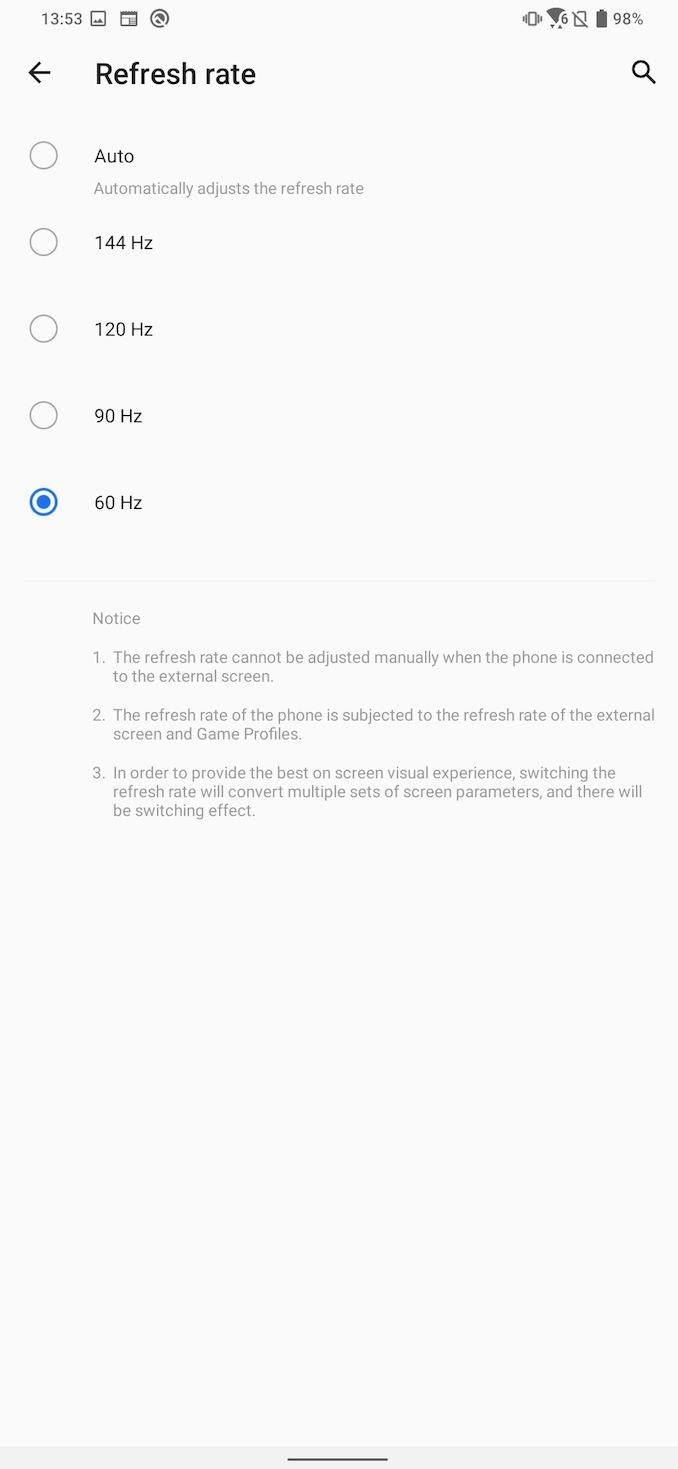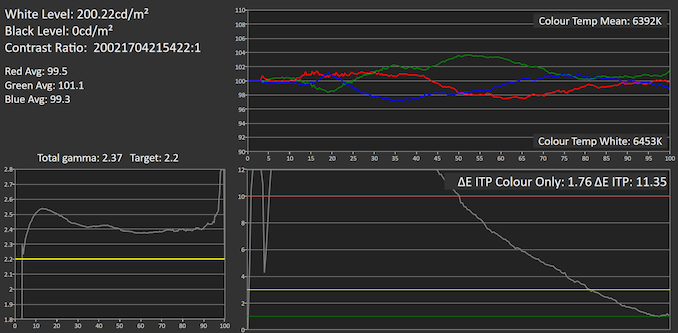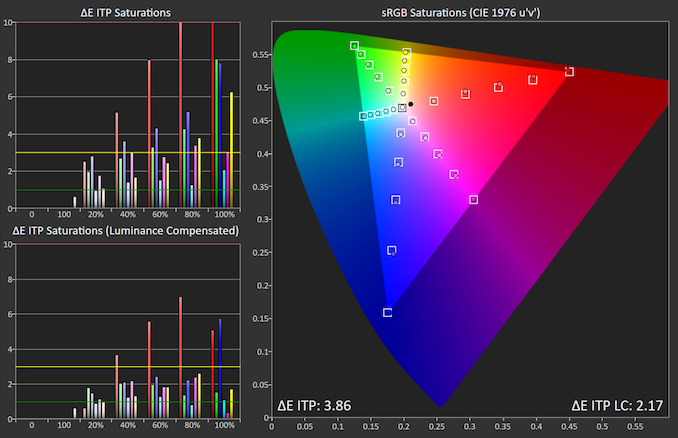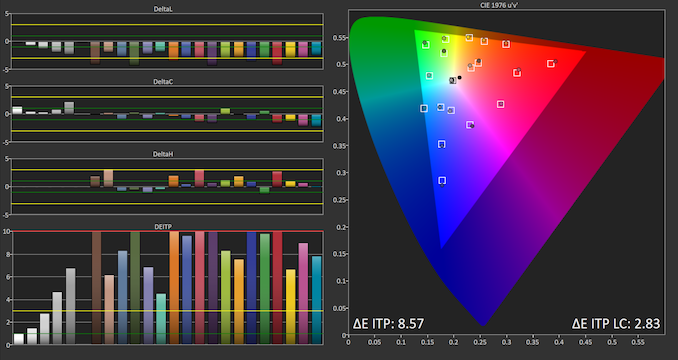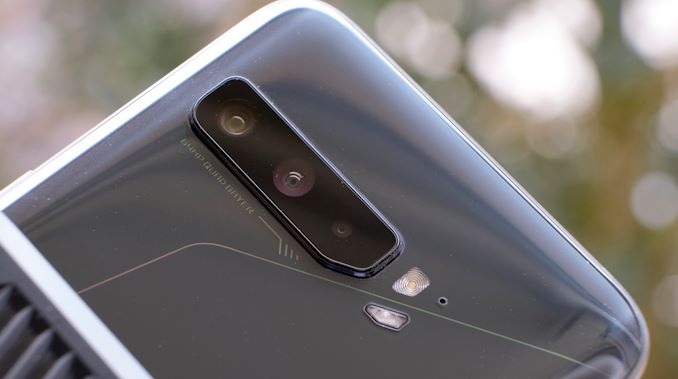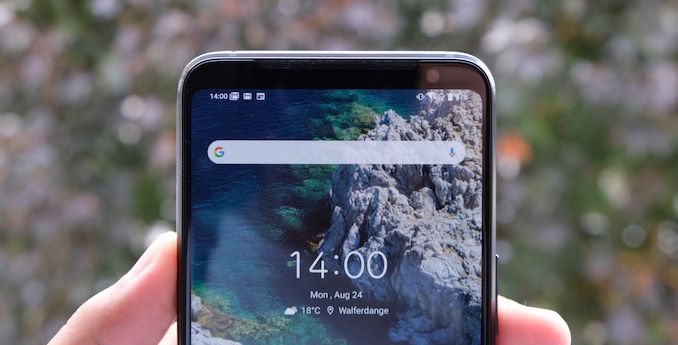
Original Link: https://www.anandtech.com/show/15982/the-asus-rog-phone-iii-review
The ASUS ROG Phone III Review: A 144Hz 6000mAh Beast With Caveats
by Andrei Frumusanu on August 28, 2020 9:00 AM EST- Posted in
- Smartphones
- Mobile
- Snapdragon 865
- ROG Phone III
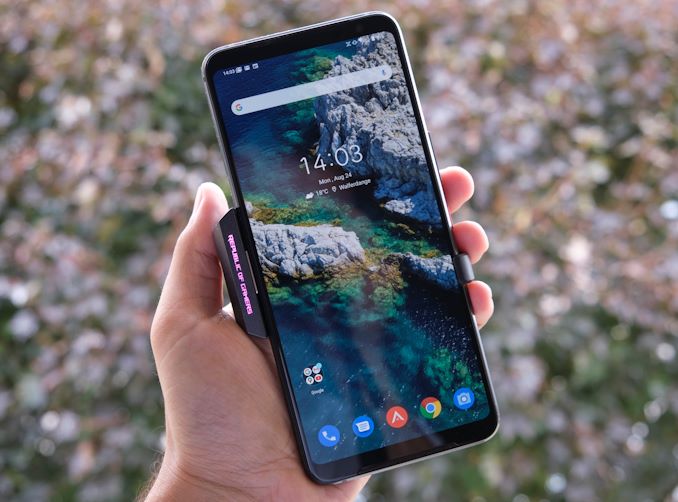
ASUS’s ROG Phones over the last few years have been devices of interesting differentiation, with the company delivering experiences that stood out from the crowd in one way or the other. This year, the new ROG Phone III doesn’t quite represent an as radical change compared to its predecessors, however ASUS makes some important upgrades and improvements to the popular gaming phone formula, updating the ROG3 to the newest Snapdragon 865+ SoC, introducing a 144Hz display, as well as most importantly, improving the every-day camera experience of the device.
This year, ASUS does things a little different in terms of model variants of the phone and their availability, releasing three SKUs with different price points ranging from 799€ to 1099€, with also differences going beyond the usual RAM+storage options as the SoC on the base variant also is different from its more expensive siblings. Let’s go over the spec sheet in more detail:
| ASUS ROG Phones | ||||||
| ROG Phone III | ROG Phone II | |||||
| SoC | Qualcomm Snapdragon 865+ 1x Cortex A77 @ 3.1GHz 3x Cortex A77 @ 2.42GHz 4x Cortex A55 @ 1.80GHz Adreno 650 @ 670MHz |
Qualcomm Snapdragon 855+ 1x Cortex-A76 @ 2.96GHz 3x Cortex-A76 @ 2.42GHz 4x Cortex-A55 @ 1.80GHz Adreno 640 @ 675MHz |
||||
| DRAM | 16 GB LPDDR5 | 12 GB LPDDR4X | ||||
| Storage | up to 512GB UFS 3.1 | 128 / 512GB UFS 3.0 | ||||
| Display | 6.59" AMOLED 2340 x 1080 (19.5:9) 144Hz 270Hz Touch |
6.59" AMOLED 2340 x 1080 (19.5:9) 120Hz 240Hz Touch |
||||
| Size | Height | 171.0 mm | 170.99 mm | |||
| Width | 78 mm | 77.6 mm | ||||
| Depth | 9.85 mm | 9.48 mm | ||||
| Weight | 240 grams | 240 grams | ||||
| Battery Capacity | 6000mAh 30W charging (PD) |
6000mAh |
||||
| Wireless Charging | - | |||||
| Rear Cameras | ||||||
| Main | 64MP IMX686 0.8µm pixels (1.6µm 4:1 16MP) f/1.8 |
48MP IMX586 0.8µm pixels (1.6µm 4:1 12MP) f/1.79 |
||||
| Telephoto | - | - | ||||
| Wide | 13MP 125° wide-angle f/2.4 |
13MP 125° wide-angle |
||||
| Extra | 5MP Macro | - | ||||
| Front Camera | 24MP | 24MP | ||||
| I/O | USB-C 3.1 (Side) + USB-C 2.0 (Bottom) |
USB-C 3.1 (Side) + USB-C 2.0 (Bottom) 3.5mm headphone jack |
||||
| Wireless (local) | 802.11ax WiFi-6 Bluetooth 5.1 LE + NFC |
802.11ac Wave 2 Wi-Fi Bluetooth 5.0 LE + NFC 802.11ad (Wireless display) |
||||
| Other Features | Dual Stereo Speakers Under-Display Fingerprint Sensor |
|||||
| Dual-SIM | Dual nanoSIM | |||||
| Launch Price | 8+256GB + S865 : 799€ 12+512GB + S865+: 999€ 16+512GB + S865+: 1099€ |
12+512GB: $899 / £829 / 899€ | ||||
Starting off with the heart of the phone, the new ROG Phone III is amongst the very first devices on the market sporting Qualcomm’s newest Snapdragon 865+ processor, and this is one of the ways that ASUS wants to differentiate itself from other phone manufacturers at this relative late stage in the device cycle generation.
The new Snapdragon 865+ ups the frequency of the prime CPU core from 2.84GHz to 3.1GHz, making this the very first mobile chip to break the 3GHz barrier, and then some, and the ROG Phone III amongst the first phones to be able to claim this. Alongside the CPU boost, we’re also seeing a 10% GPU frequency increase to 670MHz on the part of the Adreno 650.
Interestingly enough, the lowest-end model of the ROG3 makes due without the Snapdragon 865+, instead using the regular 865 which had been deployed in other competitor devices throughout the year. This variant also has 8GB of RAM and has the smallest storage capacity at 256GB, but does come significantly cheaper at 799€, versus the next-tier model at 999€, but does offer 12GB of RAM and 512GB of storage. There’s also a 16GB RAM variant at 1099€, but availability is currently spotty and frankly there’s very little benefit from the extra 4GB.
Design-wise, the ROG Phone III is very similar to its predecessor. On the part of the display, we’re still seeing a 6.59” 19.5:9 2340 x 1080 OLED display, and from the front of the device, you’d really struggle to see much of a difference to the ROG Phone II.
One area of improvement on the part of the screen is the addition of a 144Hz refresh rate option, as well as the raising of the touch controller sample rate from 240Hz to 270Hz. Generationally, these are relatively minor additions compared to the massive jump we’ve seen last year, but at least on paper it does give ASUS the slight edge in terms of specifications.
There’s no notch or punch-hole camera design here and that’s by design due to the phone’s two massive front-firing speakers that reserve quite a bit of bezel area at the top and bottom of the screen.
The back of the phone is also quite similar in design to that of the ROG2, with a few key adjustments. Key design feature still remains the phone’s ROG logo at the centre of the phone which has RGB backlighting that you can control from the software side.
The cameras this year are significantly improved: The main sensor has been upgraded to an 1/1.7” IMX686 with 64MP resolution, binning down to 16MP in regular shots. The optics have an f/1.8 lens assembly, with the big caveat that there’s no OIS available.
There’s also an ultra-wide 13MP camera module – which at least on paper seems to be the same as that of the ROG Phone II. It has an f/2.4 aperture and a 125° viewing angle.
Finally, ASUS added in a 5MP macro module as the third camera unit, but frankly as in many other phones this is relatively pointless and quite low quality. Luckily ASUS opted to use an auto-focus motor on the ZenFone 7 ultra-wide which can do double duty as a macro module there, but that doesn’t help the ROG Phone III too much.
Last year the ROG2 had a metallic design element on the side of the phone, which this year has been redesigned, downsized, and now also housed underneath the back glass. The metal piece here actually acts as a heatsink and has thermal paste to it, bonded to the back of the motherboard behind the SoC, but exactly how this helps the thermal dissipation of the phone is a bit unclear given the glass panel above it.
There’s also a small cut-out above it that tries to be a cooling exhaust, but frankly again I think this is more of a design-aesthetic piece rather than something that actually helps with the cooling of the phone.
The ROG Phone III being a gaming-oriented phone, there’s some extra gaming-only features to it, such as the two extra trigger buttons on the right hand-part of the phone (top side in landscape). These are pressure sensitive buttons and allow for software mapping to configurable virtual buttons when in a game, more on that later.
At the bottom of the phone we find an off-centre USB-C port that’s capable of USB 3.1 transfer speeds. The location is likely due to the large front-firing speaker being in the way. One huge negative of the ROG Phone III this year is that ASUS had dropped the 3.5mm headphone jack from the body, a functionality that’s now only available via the cooling fan accessory, which comes by default with the phone.
On the left side of the phone we find another USB-C port, alongside a “custom” port that serves as a proprietary accessory port. The black port is fully functional, but you’re not supposed to plug anything into the red port as the OS warns you against it.
Overall, the feel of the ROG Phone III is dominated by the fact that it’s just a very big phone. At 78mm width it’s wider than an S20 Ultra, and it’s 240g weight also makes it quite fat and heavy. Of course, that’s partly some of its allure as the internal 6000mAh battery is simply the biggest in the market in this flagship smartphone category.
Given the target audience of the phone ASUS is trying to cater to, I think there’s very little to criticise the ROG3 in terms of design and handling. The rest will depend on how it performs…
ASUS's Gaming Features
We explained that this is a gaming-oriented phone first and foremost, so we should of course cover its unique gaming features. Starting off with the physical, we should talk about the new AeroActive Cooler 3, ASUS’s active cooling solution for the ROG Phone III.
The accessory comes included by default with the phone which is a positive as it’s essentially the key add-on that’s supposed to make the ROG3 what it is.
The cooler accessory is quite light-weight at 38g and is made of plastic. It’s primarily made of two separate sections with the whole unit extending out to be able to grip around the phone when connected. The ROG logo at the back as well as the “Republic of Gamers” label on the front are RGB and light up in the same fashion as the ROG logo on the back of the phone.
The inside part of the cooler contains the dual USB-C connector that attaches to the phone, with the other side only having a little plastic hook that wraps around the side-frame of the right side of the phone, below the power button.
When holding the phone in landscape the cooler is well positioned and really doesn’t get into your way of things which is good – it does however significantly increase the size of the phone as a whole if you’re to carry it around in your pocket in this way.
The interesting aspect of the cooler is exactly how it cools the phone. This actually isn’t a fan that is supposed to be blowing air onto the back of the phone, as in the earlier picture you see that there’s essentially no ventilation holes that actually blow to that part of the phone. There’s also a noticeable gap in-between the cooler and the phone itself, and the tiny fan hardly generates enough pressure to get enough airflow at the phone’s surface.
What I think actually happens is that the AeroCooler is cooling the phone via the USB-C connectors. The combo-connector lies on the motherboard directly next to the SoC as well as the small metal heatsink underneath the back glass. My theory is that heat is being transferred from the motherboard through the quite large double USB-C connectors to the AeroCooler itself, which dissipates this internally and vents out through the slits on this side of the phone.
By the way, that small slit on the phone itself isn’t even covered by the AeroCooler vents, which further reinforces my notion that it’s just there for design and doesn’t have any practical use for cooling of the phone.
The AeroCooler has a 3.5mm headphone jack as well as a functional USB-C port. It’s a pity that this is the only way to get audio out of the phone – there’s no other 3.5mm adapter included in the box.
Software, wise, there’s two ways to take advantage of ASUS’s gaming features. In general use, you can switch the whole phone into “X-Mode” from the notification area toggle.
X-Mode has three settings levels by default here, LV1, LV2, and LV3, all differing in their performance and well as thermal limits tunings. LV1 merely boosts CPU minimum frequencies to a higher minimum, partly disabling “normal” DVFS operation. LV2 further raises these minimums as well as raises the thermal throttling temperature limits of the phone – in general LV1 will allow for skin temperatures up to 37°C, while LV2 will go up to around 45°C peaks.
LV3 will completely disable DVFS of the SoC and run the CPUs and GPU at maximum frequency all the time – the caveat here is that this mode can only be enabled when the AeroCooler is connected.
Beyond the global X-Mode settings, you can also fine-tune things via ASUS’s Armory Crate application, where you can set per-app profiles and in which you have a ton more options beyond the three X-Mode levels.
There are simplified controls in which you can set the three DVFS minimum control as well as thermal throttling limitations, or you can go fine-tune things via the advanced controls.
The advanced controls are indeed quite advanced and allow you to fully control essentially all DVFS tuneables of the CPU, GPU, memory controller drivers, as well as fine-tune the system schedulers and even I/O performance settings. Pretty much ASUS gives you full control over this aspect of the device, controls you usually only would have if you had rooted your phone.
The other important Armory Crate setting is the refresh rate configuration page where ASUS also exposes an anti-aliasing toggle for 4xMSAA, something that I think is very nice to have given a lot of games nowadays still don’t allow for full native rendering resolutions.
ASUS’s game engine is a in-game control panel which can be called up by swiping from the left of the screen while in an app or a game, and gives you various nifty features that might be useful to you while gaming.
The most important feature here beyond your slew of system setting toggles, performance settings shortcuts, and other gimmicks, is the ability to set up the air triggers of the phone and set their inputs to the game you’re playing.
The air-triggers are in my opinion still the single most important aspect of the ROG Phone III as a gaming phone as it really gives you that extra control ability, especially in 3D shooter games. This allowed me seamless moving, aiming, and shooting all simultaneously, which might be a little more hindersome on other traditional phones.
The one disappointing aspect of the phone in games was the refresh-rate: Although the phone goes up to 144Hz, there’s very little games out there which can actually take advantage of this. For example in the PUBG session above, the game still capped out at 60fps rendering, and given this is one of the most popular games on the market, it does more significantly reduce the value of the high-refresh-rate screen for gaming.
System Performance
System performance of the ROG Phone III should be interesting given its gaming phone nature, as well as for the fact that it’s the first Snapdragon 865+ device we’ve come to test. As always, system performance doesn’t necessarily just depend on the hardware of a device, but also on the software tuning that a vendor does to its DVFS and SoC scheduler settings.
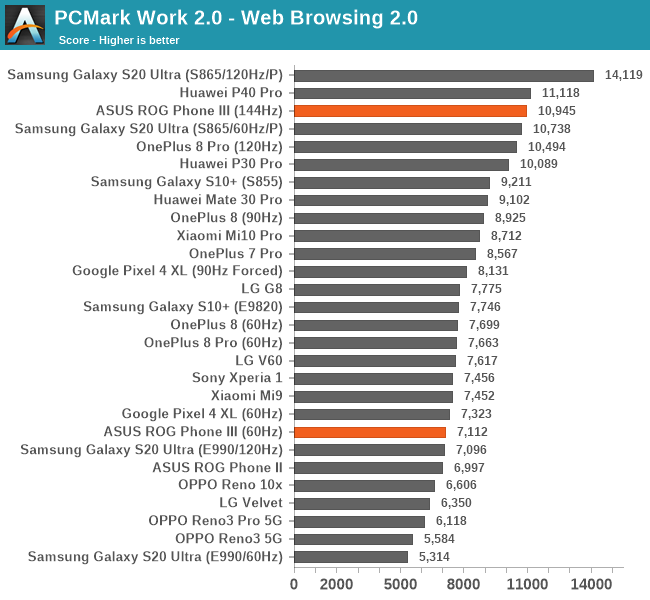
In the PCMark web-browsing test, the workload is quite sensible to scheduler and DVFS settings. Here the ROG Phone III is rather conservatively tuned in its 60Hz setting, only catching up due to the higher 144Hz refresh rate when in that mode.
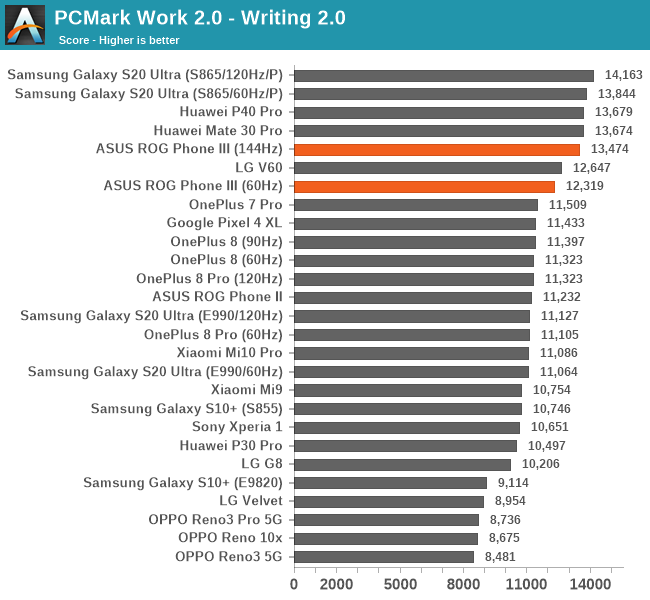
The writing sub-test is the most important of PCMark, and the ROG3 here fares slightly better than most other Snapdragon 865 devices on the market, but falls just short of Kirin 990 phones as well as the Snapdragon Galaxy S20.
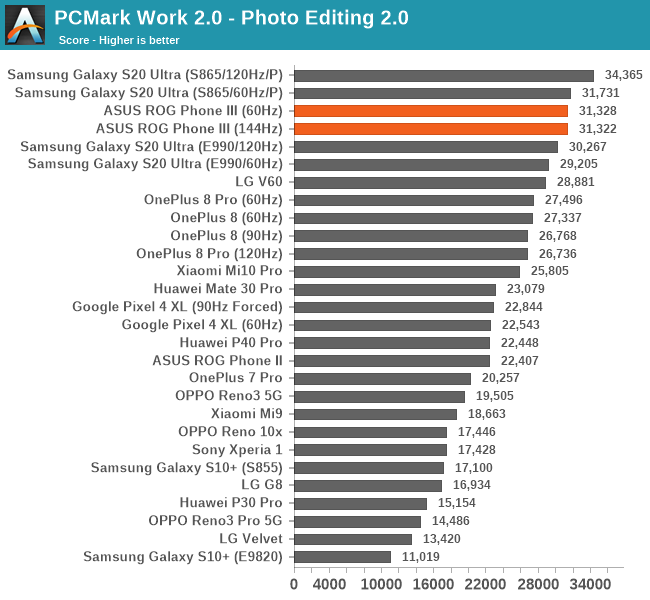
We see a similar positioning for the photo editing test.
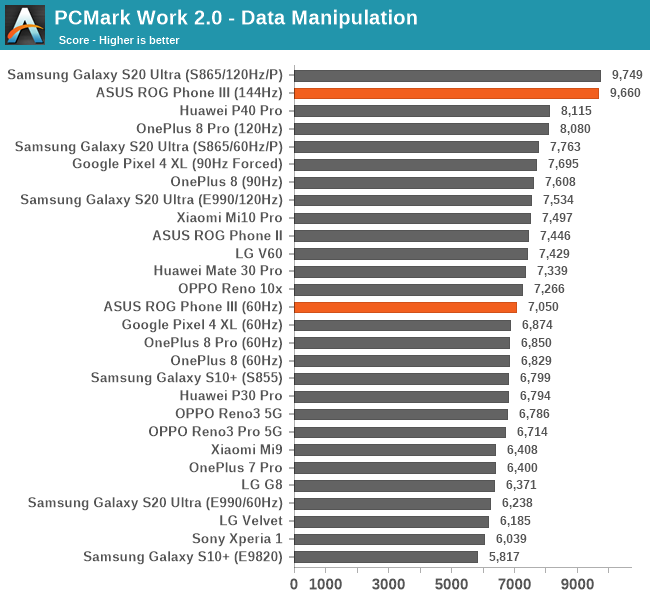
The data-manipulation test seems refresh-rate bottlenecked and here the ROG3 sees a big jump when scaling from 60 to 144Hz.
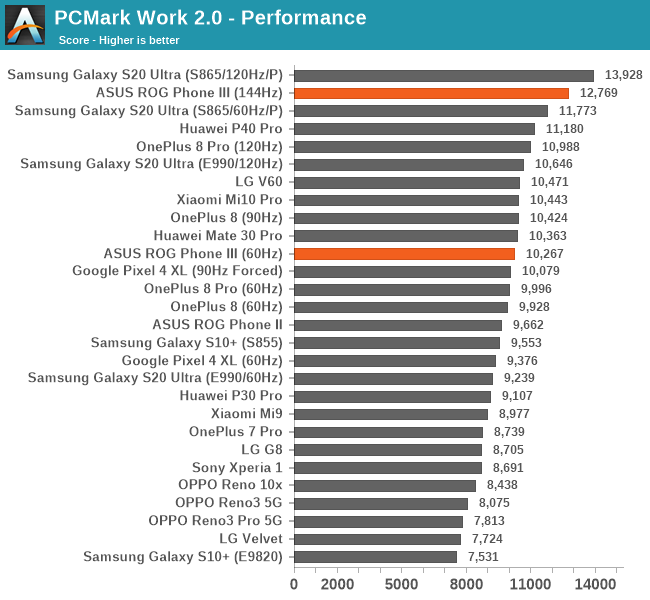
Overall, in the PCMark performance scores, the ROG Phone III only falls short to the Snapdragon Galaxy S20 Ultra in our tests. There are a few details I want to expand in regards to this positioning and why it doesn’t fare better:
The test scores here were performed under the phone’s default operating conditions, with X-Mode being disabled. Unfortunately, it seems that under these conditions, the phone’s performance is very conservative and doesn’t really stand out much from the crowd.
The scores are significantly improved when enabling X-Mode, however I take issue in publishing these figures into our charts given that what this mode does is simply cripple normal DVFS operation of the SoC by raising the minimum operating frequencies, or essentially just pegging them to their maximum.
There’s been a delicate balance by various vendor’s performance modes, some which implement quite reasonable settings, whilst other simply are akin to just enabling a benchmark cheat mode. Samsung’s and Huawei’s performance modes are still reasonable as they still use the full dynamic range operating frequencies of the SoC, only increasing the aggressiveness of the scaling behaviour.
Other vendors such as OPPO, and ASUS here, just enable a rather dumb “all-out” mode that in my view isn’t very realistic for a battery powered device, and that I wouldn’t recommend anyone on actually using. I’ll get into more detail about this in the GPU performance section, but I don’t find the default X-Mode levels particularly well implemented when it comes to the balance between performance and power consumption.
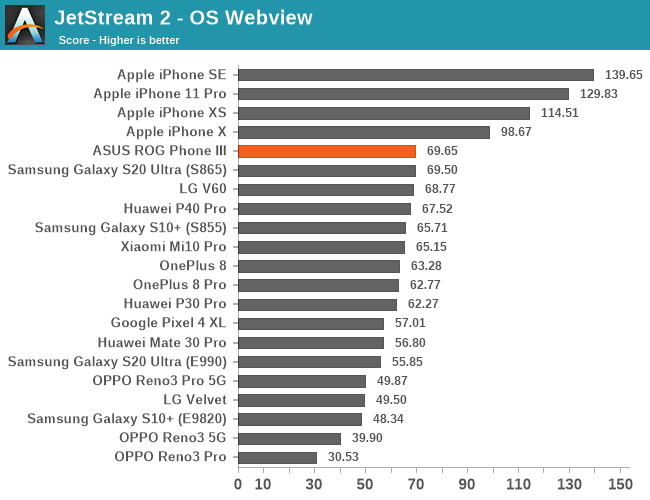

The ROG Phone III did adequately in the browser Javascript benchmarks, although WebXPRT 3 does showcase its rather conservative performance tuning when in its default operating mode.
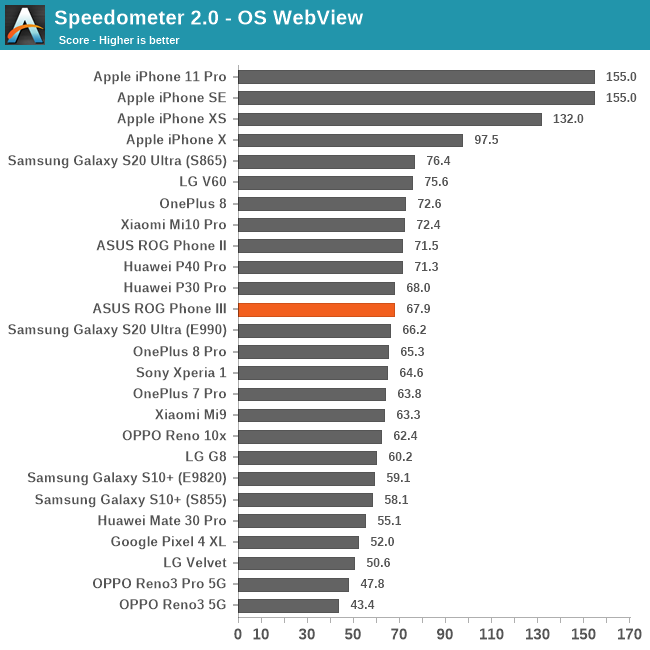
I had some really odd issues with Speedometer 2.0, in that the ROG Phone III kept performing quite horribly in WebView containers as well as Chrome. I’m not sure what happened here, as the same versions of the apps performed quite well on other Snapdragon 865 devices, which points out to possibly some OS-specific issue on the ASUS device. Using Samsung Internet for example made it perform normally – really odd.
Update: The issue has been resolved with the latest firmware update.
Overall, system performance of the ROG Phone III is excellent, but generally I wouldn’t say that it’s in any way class-leading or able to distinguish itself from other 120Hz phones. The 144Hz mode isn’t something that you will notice over other 120Hz phones, and whilst the phone is very snappy, without the questionable every-day use of X-Mode, it lags behind Samsung’s devices. In this regard, the ROG3 doesn’t perform much differently to any other high-refresh rate Snapdragon 865 phones.
GPU Performance & Power
GPU performance of the ROG Phone III should be its very strong-point, as that’s the primary selling point of the device. The new Snapdragon 865+ promises 10% better performance than the regular Snapdragon 865, and we’ve seen quite a few excellently performing S865 devices over the last few months.
How will the ROG3 be able to distinguish itself from the crowd with its fancy cooling solutions, given that the crowd already performs that well?
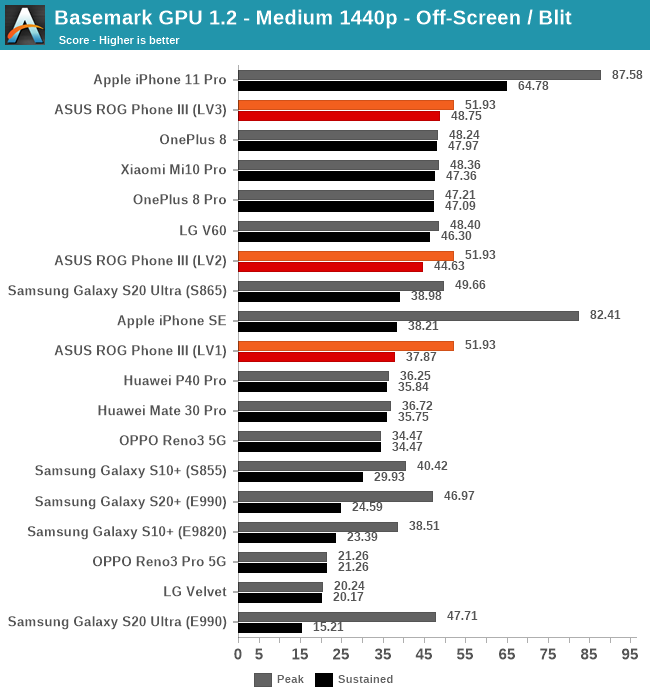
Starting off with Basemark GPU 1.2, we’re off to some odd results.
In the default mode (LV1), the phone’s peak performance is right about where expect it to be, roughly 10% faster than Snapdragon 865 devices in the market. What’s rather disappointing is the phone’s sustained performance figures which are significantly worse than other phones in the market.
I noted that the phone didn’t really get hot at all in its default operating mode, with peak skin temperature not exceeding 37°C which is very conservative. I decided to also test the gaming performance in its X-Modes;
At LV2, the phone gets notably hotter and is allowed to reach up to around 45°C peak skin temperatures, with sustained performance getting a nice boost. However, versus the competition, these results are still a tad disappointing as it still lags behind LG, Xiaomi and OnePlus phones, all of which are actually cooler.
Finally, in LV3 mode with the AeroCooler connected, the phone gets a slight sustained performance boost, finally taking the top place amongst Android devices, albeit with only a sliver of a margin.
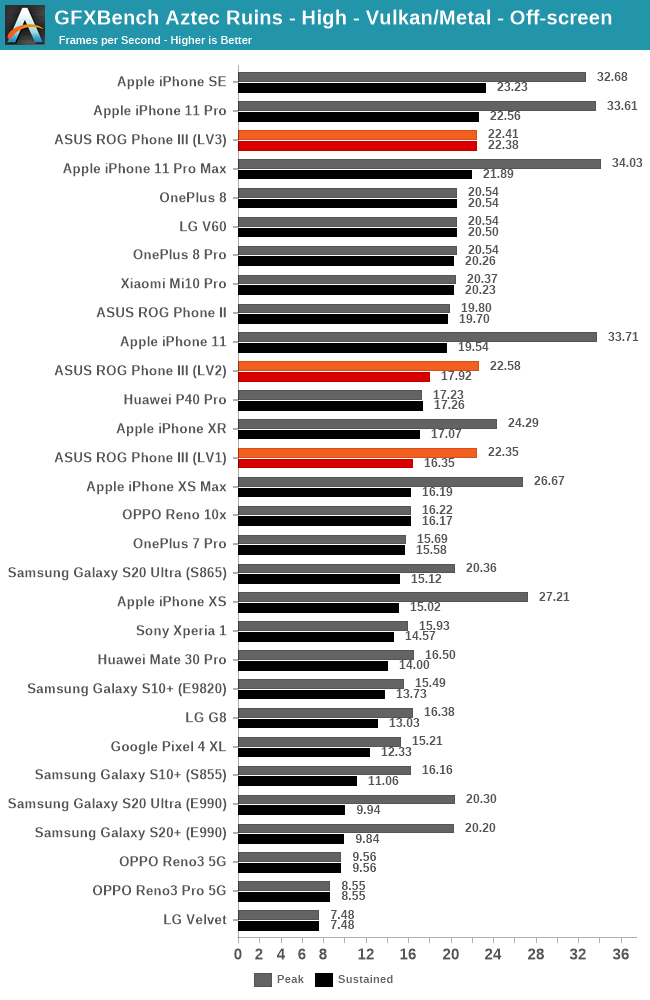
GFXBench Aztec High showcases a similar performance raking, with the default mode ROG3 performing very conservatively, requiring the AeroCooler to be able to keep up with other phones in the market.
| GFXBench Aztec High Offscreen Power Efficiency (System Active Power) |
||||
| Mfc. Process | FPS | Avg. Power (W) |
Perf/W Efficiency |
|
| iPhone 11 Pro (A13) Warm | N7P | 26.14 | 3.83 | 6.82 fps/W |
| iPhone 11 Pro (A13) Cold / Peak | N7P | 34.00 | 6.21 | 5.47 fps/W |
| Galaxy S20 Ultra (Snapdragon 865) | N7P | 20.35 | 3.91 | 5.19 fps/W |
| iPhone XS (A12) Warm | N7 | 19.32 | 3.81 | 5.07 fps/W |
| Reno3 5G (Dimensity 1000L) | N7 | 11.93 | 2.39 | 4.99 fps/W |
| iPhone XS (A12) Cold / Peak | N7 | 26.59 | 5.56 | 4.78 fps/W |
| ROG Phone III (Snapdragon 865+) | N7P | 22.34 | 5.35 | 4.17 fps/W |
| Mate 30 Pro (Kirin 990 4G) | N7 | 16.50 | 3.96 | 4.16 fps/W |
| Galaxy S20+ (Exynos 990) | 7LPP | 20.20 | 5.02 | 3.59 fps/W |
| Galaxy S10+ (Snapdragon 855) | N7 | 16.17 | 4.69 | 3.44 fps/W |
| Galaxy S10+ (Exynos 9820) | 8LPP | 15.59 | 4.80 | 3.24 fps/W |
GFXBench Aztec High showcases a similar performance raking, with the default mode ROG3 performing very conservatively, requiring the AeroCooler to be able to keep up with other phones in the market.
It was very odd to see the ROG3 perform quite this poorly, and most importantly getting that much hotter than the competition. I re-measured the power consumption of the device and the Snapdragon 865+ only to note that the new SoC is seemingly using quite a lot more power than the standard Snapdragon 865, reaching up to 5.35W versus 3.91W on the Galaxy S20 Ultra.
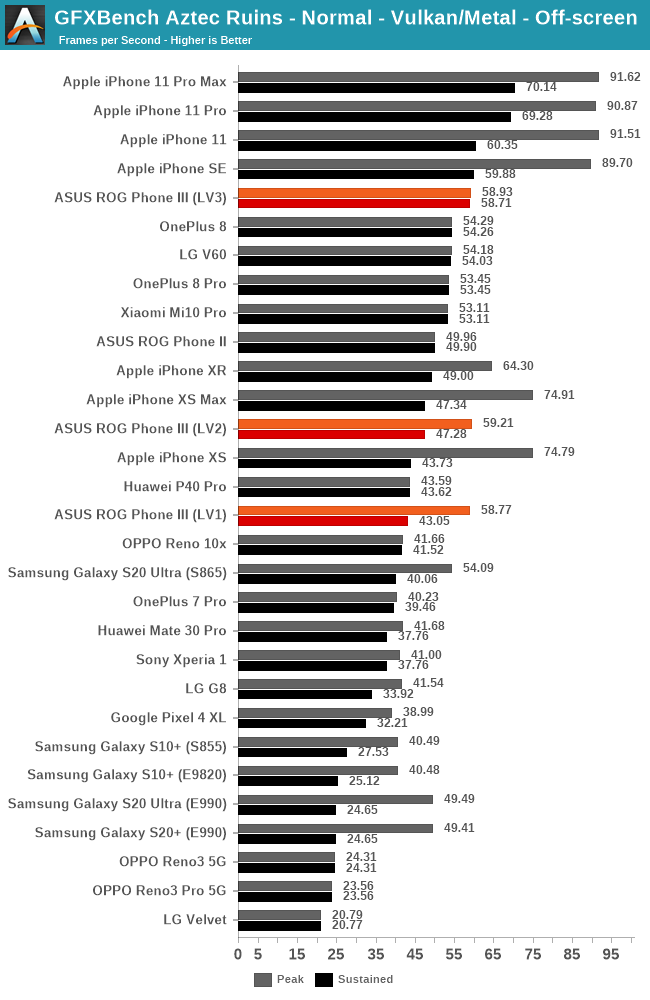
| GFXBench Aztec Normal Offscreen Power Efficiency (System Active Power) |
||||
| Mfc. Process | FPS | Avg. Power (W) |
Perf/W Efficiency |
|
| iPhone 11 Pro (A13) Warm | N7P | 73.27 | 4.07 | 18.00 fps/W |
| iPhone 11 Pro (A13) Cold / Peak | N7P | 91.62 | 6.08 | 15.06 fps/W |
| iPhone XS (A12) Warm | N7 | 55.70 | 3.88 | 14.35 fps/W |
| Galaxy S20 Ultra (Snapdragon 865) | N7P | 54.09 | 3.91 | 13.75 fps/W |
| iPhone XS (A12) Cold / Peak | N7 | 76.00 | 5.59 | 13.59 fps/W |
| Reno3 5G (Dimensity 1000L) | N7 | 27.84 | 2.12 | 13.13 fps/W |
| ROG Phone III (Snapdragon 865+) | N7P | 58.77 | 5.34 | 11.00 fps/W |
| Mate 30 Pro (Kirin 990 4G) | N7 | 41.68 | 4.01 | 10.39 fps/W |
| Galaxy S20+ (Exynos 990) | 7LPP | 49.41 | 4.87 | 10.14 fps/W |
| Galaxy S10+ (Snapdragon 855) | N7 | 40.63 | 4.14 | 9.81 fps/W |
| Galaxy S10+ (Exynos 9820) | 8LPP | 40.18 | 4.62 | 8.69 fps/W |
Aztec normal showcases the same results and power draw characteristics.
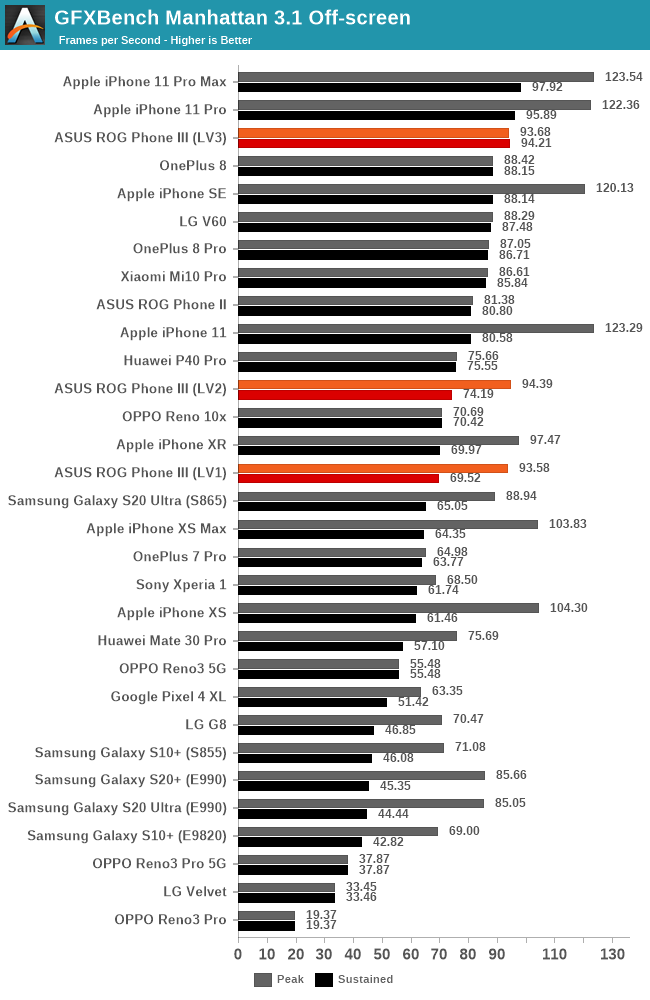
| GFXBench Manhattan 3.1 Offscreen Power Efficiency (System Active Power) |
||||
| Mfc. Process | FPS | Avg. Power (W) |
Perf/W Efficiency |
|
| iPhone 11 Pro (A13) Warm | N7P | 100.58 | 4.21 | 23.89 fps/W |
| Galaxy S20 Ultra (Snapdragon 865) | N7P | 88.93 | 4.20 | 21.15 fps/W |
| iPhone 11 Pro (A13) Cold / Peak | N7P | 123.54 | 6.04 | 20.45 fps/W |
| iPhone XS (A12) Warm | N7 | 76.51 | 3.79 | 20.18 fps/W |
| Reno3 5G (Dimensity 1000L) | N7 | 55.48 | 2.98 | 18.61 fps/W |
| iPhone XS (A12) Cold / Peak | N7 | 103.83 | 5.98 | 17.36 fps/W |
| ROG Phone III (Snapdragon 865+) | N7P | 93.58 | 5.56 | 16.82 fps/W |
| Mate 30 Pro (Kirin 990 4G) | N7 | 75.69 | 5.04 | 15.01 fps/W |
| Galaxy S20+ (Exynos 990) | 7LPP | 85.66 | 5.90 | 14.51 fps/W |
| Galaxy S10+ (Snapdragon 855) | N7 | 70.67 | 4.88 | 14.46 fps/W |
| Galaxy S10+ (Exynos 9820) | 8LPP | 68.87 | 5.10 | 13.48 fps/W |
| Galaxy S9+ (Snapdragon 845) | 10LPP | 61.16 | 5.01 | 11.99 fps/W |
| Mate 20 Pro (Kirin 980) | N7 | 54.54 | 4.57 | 11.93 fps/W |
| Galaxy S9 (Exynos 9810) | 10LPP | 46.04 | 4.08 | 11.28 fps/W |
| Galaxy S8 (Snapdragon 835) | 10LPE | 38.90 | 3.79 | 10.26 fps/W |
| Galaxy S8 (Exynos 8895) | 10LPE | 42.49 | 7.35 | 5.78 fps/W |
Manhattan 3.1 is the same as well; here the power consumption grows to up to 5.56W which is extremely high and well beyond that a smartphone can normally dissipate.

| GFXBench T-Rex Offscreen Power Efficiency (System Active Power) |
||||
| Mfc. Process | FPS | Avg. Power (W) |
Perf/W Efficiency |
|
| iPhone 11 Pro (A13) Warm | N7P | 289.03 | 4.78 | 60.46 fps/W |
| iPhone 11 Pro (A13) Cold / Peak | N7P | 328.90 | 5.93 | 55.46 fps/W |
| Galaxy S20 Ultra (Snapdragon 865) | N7P | 205.37 | 3.83 | 53.30 fps/W |
| iPhone XS (A12) Warm | N7 | 197.80 | 3.95 | 50.07 fps/W |
| ROG Phone III (Snapdragon 865+) | N7P | 224.48 | 4.92 | 45.60 fps/W |
| iPhone XS (A12) Cold / Peak | N7 | 271.86 | 6.10 | 44.56 fps/W |
| Galaxy 10+ (Snapdragon 855) | N7 | 167.16 | 4.10 | 40.70 fps/W |
| Reno3 5G (Dimensity 1000L) | N7 | 139.30 | 3.57 | 39.01 fps/W |
| Galaxy S20+ (Exynos 990) | 7LPP | 199.61 | 5.63 | 35.45 fps/W |
| Mate 30 Pro (Kirin 990 4G) | N7 | 152.27 | 4.34 | 35.08 fps/W |
| Galaxy S9+ (Snapdragon 845) | 10LPP | 150.40 | 4.42 | 34.00 fps/W |
| Galaxy 10+ (Exynos 9820) | 8LPP | 166.00 | 4.96 | 33.40fps/W |
| Galaxy S9 (Exynos 9810) | 10LPP | 141.91 | 4.34 | 32.67 fps/W |
| Galaxy S8 (Snapdragon 835) | 10LPE | 108.20 | 3.45 | 31.31 fps/W |
| Mate 20 Pro (Kirin 980) | N7 | 135.75 | 4.64 | 29.25 fps/W |
| Galaxy S8 (Exynos 8895) | 10LPE | 121.00 | 5.86 | 20.65 fps/W |
T-Rex also shows a big increase in power consumption, over 1W worse than the Snapdragon 865.
Power-hungry Snapdragon 865+?
Overall, the ROG Phone III’s disappointing thermals and rather odd and worse sustained performance figures seem to be explained by the new SoC’s vastly increased power consumption characteristics. I made sure that this wasn’t just a measurement fluke, both in regards to power and the sustained performance figures and went ahead and retested a past phone such as the Mi 10 Pro, and I got the very same results. The regular non-gaming Snapdragon 865 phone was just cooler than the ROG Phone III, and was able to maintain higher performance over prolonged periods of time than the ASUS device.
Yes, the AeroCooler does help with the dissipation of heat, but in absolute terms, that’s a quite high price to pay in order to get a tiny advantage over other devices which don’t require any extra cooling.
Display Measurement
The display on the ROG Phone III is an OLED panel that features a 1080p resolution and a very high refresh-rate of up to 144Hz. Although it was something quite extraordinary back in 2019, in 2020 it’s doesn’t showcase the same kind of spec-list advantage versus the 1440p 120Hz panels by some other competitors in the market.
The phone gives you the options to operate at 60, 90, 120 or 144Hz which is quite wide array of selections. Unfortunately, much like other super-high refresh-rate panels on the market, going beyond 90Hz comes at a quite larger power consumption cost.
Colour settings on the ROG Phone III are very varied and customisable, giving you four different predefined display gamut selections. The “standard” profile is the calibrated sRGB target with a default colour temperature near 6500K, so that’s what we measured and what I would recommend users to choose when looking for accurate display colours.
We move on to the display calibration and fundamental display measurements of the ROG Phone III screen. As always, we thank X-Rite and SpecraCal, as our measurements are performed with an X-Rite i1Pro 2 spectrophotometer, with the exception of black levels which are measured with an i1Display Pro colorimeter. Data is collected and examined using Portrait Display's CalMAN software.
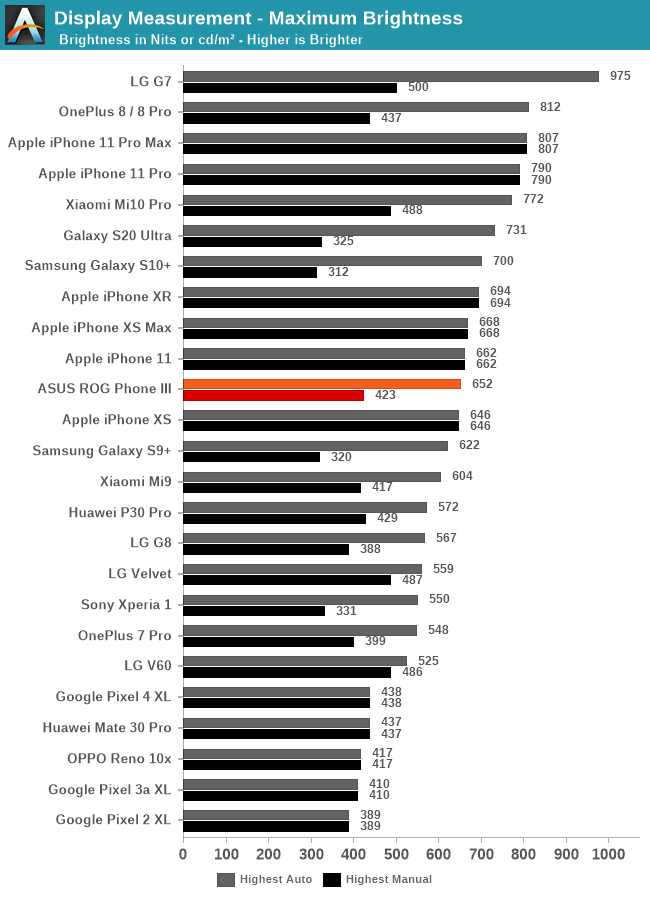
In terms of brightness, the ROG Phone III fares well, with manual brightness reaching up to around 423cd/m², whilst when in adaptive brightness mode this boosts up to 652cd/m² full-screen white (100% APL) when under bright ambient light conditions.
In the standard display profile, colour temperature is quite good at the high levels, tracking whites at 6453K. At the mid-levels there’s a bit too much greens.
Although greyscale colour accuracy is quite excellent with a dEITP of only 1.76, the overall error rate when including luminosity is quite bad in our results here, and the reason for that is that the phone is targeting a much higher gamma of around 2.4. Unfortunately this aspect is valid for all colour profiles of the phone and there’s no way to fine-tune or change this.
What this means is that mid- and low-levels will appear darker than they are meant to.
Saturation accuracy against the sRGB target is excellent, with only minor deviations which are exaggerated by the higher gamma target of the display profile.
The Gretag MacBeth chart of common colour tones and skin tones is also quite accurate in terms of colour saturations and hues, however the off-target luminosity because of the higher gamma is the main reason the total dEITP error rate is quite high at 8.57.
Overall, the screen of the ROG Phone III is excellent, although not class-leading. It’s not quite as high resolution or as bright as some competitors, but it still fares very well, and it’s currently amongst a very small number of phones which can claim a 144Hz refresh-rate, although the actual benefits of that over 120Hz devices is rather minor.
Colour accuracy is good, although you’d have to get used to that higher gamma target which produces darker colour tones.
Battery Life - The Best
The previous generation ROG Phones have impressed us a lot when it comes to their battery life, and that’s easily attributed to the massive 6000mAh battery that’s included in the 240g heavy phone.
The ROG Phone III this year doesn’t increase battery capacity, but does feature a more efficient SoC that should showcase even better results. The minor bump to 144Hz shouldn’t come with a notable power consumption increase.

As expected, the ROG Phone III is topping our battery life charts. At 60Hz refresh rate, the new phone slightly edges out the older ROG Phone II with an astounding 16.51h runtime.
Turning on the 144Hz refresh rate comes with a large 22% hit in battery life, but in absolute terms it still maintains an excellent 12.9h runtime, making this the longest-lasting phone amongst the 120Hz+ crowd.
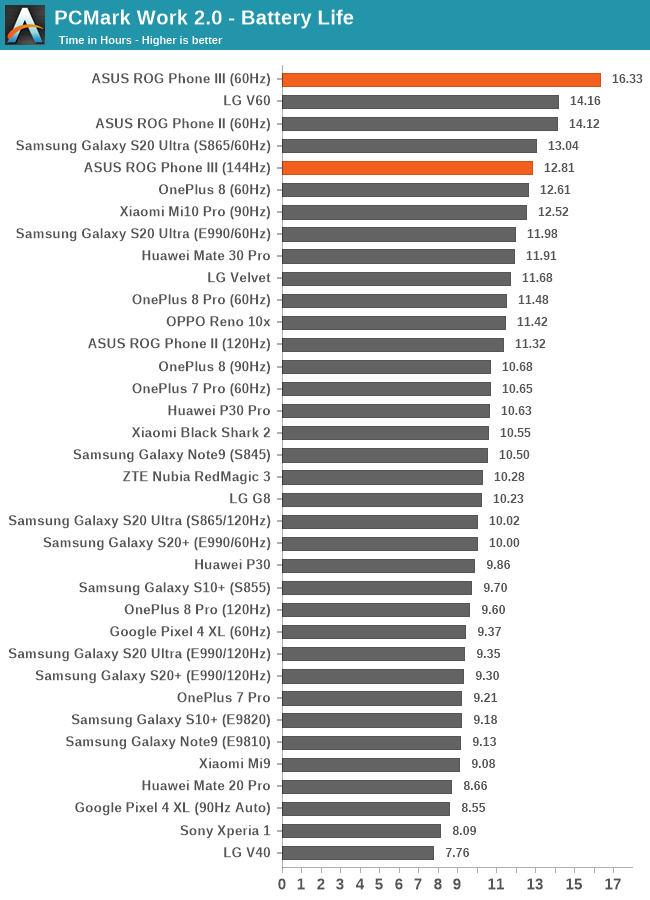
In PCMark, the improved power efficiency of the new SoC is further exposed, with the newer generation having a bigger leap of the Snapdragon 855 ROG Phone II.
The absolute battery life runtimes here are outstanding.
Overall, there’s very little to say about the ROG Phone III’s battery life other than it being class-leading. There’s no other flagship device out there with such great battery life, as vendors only employ such huge battery capacities in lower-end devices. You have to pay the price in terms of device weight, but you’re also getting a lot in return.
Camera - Daylight Evaluation
The cameras of the ROG Phone III aren’t the most exciting, but do represent a partial upgrade compared to its predecessor. The new 64MP IMX686 main camera sensor with its f/1.7 optics are certain to produce higher-quality images. The ultra-wide-angle seems to be the same unit as on the ROG Phone II, however we do hope that the improved processing of the new SoC will be able to improve the quality of the images.
The only rather obvious lacking feature here is the missing OIS on the main camera sensor. For daylight shots this shouldn’t be too much of an issue, but for low-light it’ll certainly handicap the ROG3. Let’s start with daylight shots though:
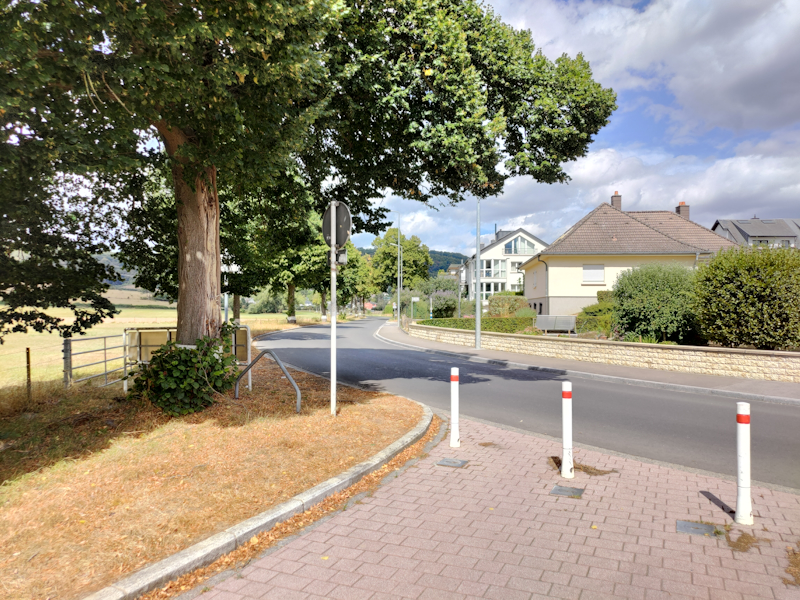
[ ROG Phone III ]
[ iPhone 11 Pro ] - [ Galaxy S20+(E) ]
[ Pixel 4 ] - [ X-T30 ]
In the first shot here we’re seeing the ROG3 having a quite different exposure compared to other phones. While other phones were exposing for the highlights of the scene, the ASUS exposed for the shadows, and thus has a lot more retention into the darker areas of the scene such as the tree crown. Unfortunately, that doesn’t work too great for the brighter parts of the scene as things look quite flat and crushed due to the HDR trying to reduce highlights back to normal levels.
The ultra-wide has similar issues, with good shadows, however the highlights are too flat and crushed.

[ ROG Phone III ]
[ iPhone 11 Pro ] - [ Galaxy S20+(E) ]
[ Pixel 4 ] - [ X-T30 ]
This scene’s exposure is quite good on the ROG3, though it doesn’t have the best dynamic range. Colour temperature is also too warm, but that’s an issue all the phones had here, except for the iPhone which was more spot-on.
It’s a detail rich-scene and a perfect spot to investigate the resolution of the cameras. The ROG3 doesn’t do well at all there – although the centre of the image is quite sharp, starting in the mid-frame there’s a vast drop in optical resolution resulting in quite abysmal blur towards the edges of the image, which is amongst the worst we’ve seen in a phone. It looks like the optics of the ROG3 are quite bad.

[ ROG Phone III ]
[ iPhone 11 Pro ] - [ Galaxy S20+(E) ]
[ Pixel 4 ] - [ X-T30 ]
In the next shot the exposure is again adequate, but still a bit too flat for the highlights of the scene, as its textures are a bit flat. Even in the thumbnail view we can see the low edge sharpness of the camera versus the other phones which is quite a pity.
The ultra-wide is also dominated by this overexposure and flat highlight elements, it’s notably worse than the competition.

[ ROG Phone III ]
[ iPhone 11 Pro ] - [ Galaxy S20+(E) ]
[ Pixel 4 ] - [ X-T30 ]
In what I guess is less stringent lighting, the ROG3 does a better overall exposure, although this time we see a lack of dynamic range in the shadows, which are clipping to black.

[ ROG Phone III ]
[ iPhone 11 Pro ] - [ Galaxy S20+(E) ]
[ Pixel 4 ] - [ X-T30 ]
This shot is quite nice for the ASUS, although it lacks dynamic range compared to the other phones. Colour temperature is a bit too warm.

[ ROG Phone III ]
[ iPhone 11 Pro ] - [ Galaxy S20+(E) ]
[ Pixel 4 ] - [ X-T30 ]
Under cloud-cover, the exposure ended up being quite dark as the phone tries to expose for the sky rather than for the majority of the scene, which lacked in any kind of highlights.
The ultra-wide here did a better job, resulting in a livelier and more accurate image.
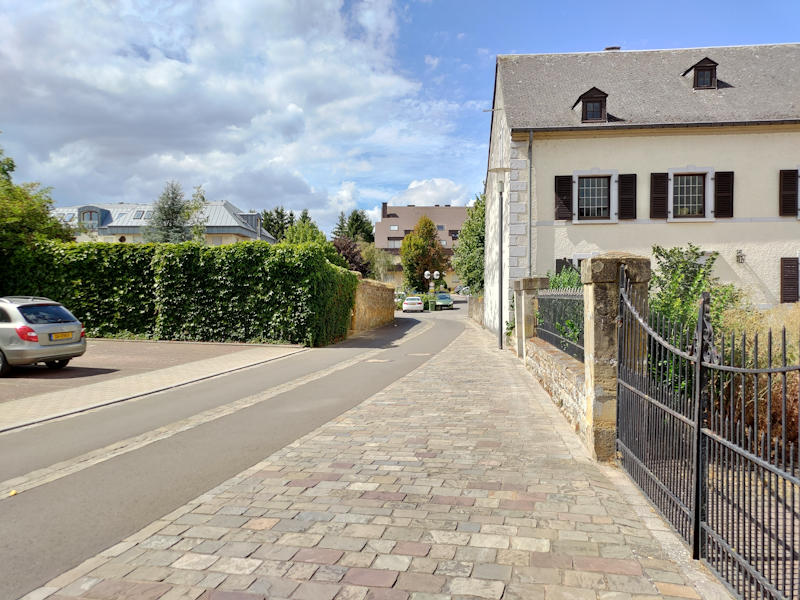
[ ROG Phone III ]
[ iPhone 11 Pro ] - [ Galaxy S20+(E) ]
[ Pixel 4 ] - [ X-T30 ]
Finally, when back in sunlight, the camera again overexposed things and attempted to recover the highlights by lowering them, resulting in flat textures without contrast.
Overall Daylight Capture – Disappointing
The ROG Phone II last year didn’t have a great camera, and it seems to me the ROG Phone III doesn’t improve the situation much even though it sports new hardware.
The issue seems to be solely on the processing side. The phone in daylight has a tendency to overexpose, with the HDR then trying to lower highlights back to normal levels, which then result into flat textures.
It’s a functional camera, but I can’t say that it’s able to compete with any other flagship phone in the market as pretty much almost everything else out there will be able to produce better images.
Hardware-wise, the optics of the main camera sensor are also severely lacking. There’s a very gross loss of optical acuity starting mid-frame, with very blurry edges. The optics here don’t seem to be able to actually be fit for an f/1.7 aperture at all.
Camera - Low Light Evaluation
Low-light photography of the ROG Phone III is a wildcard. On one hand, the phone lacks OIS which is a big detriment to low-light photography, but on the other hand, the device has a potent sensor, wide aperture, and now also features a night mode that might be able to still produce good images.
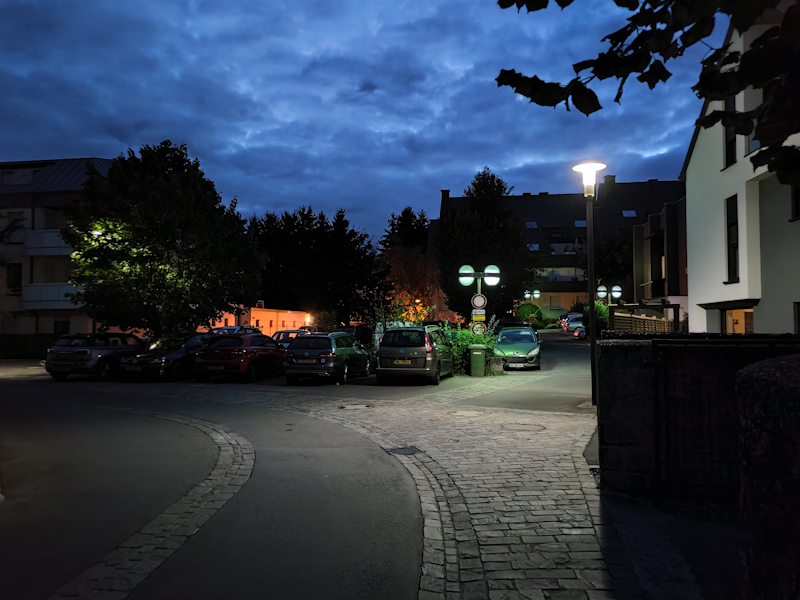
[ ROG Phone III ]
[iPhone 11 Pro ] - [Galaxy S20+(E) ]
[ Pixel 4 ] - [ X-T30 ]
As expected, the non-night mode shots of the phone are quite disappointing and are considerably worse than the competition.
The ultra-wide here is also night unusable and in the same bottom-tier as the iPhone 11’s unit.
When turning on night mode however, which by the way is triggered to come on by default when under low-light conditions, there’s a dramatic improvement in quality and it becomes usable, although it still can’t compete with other phones which have OIS.
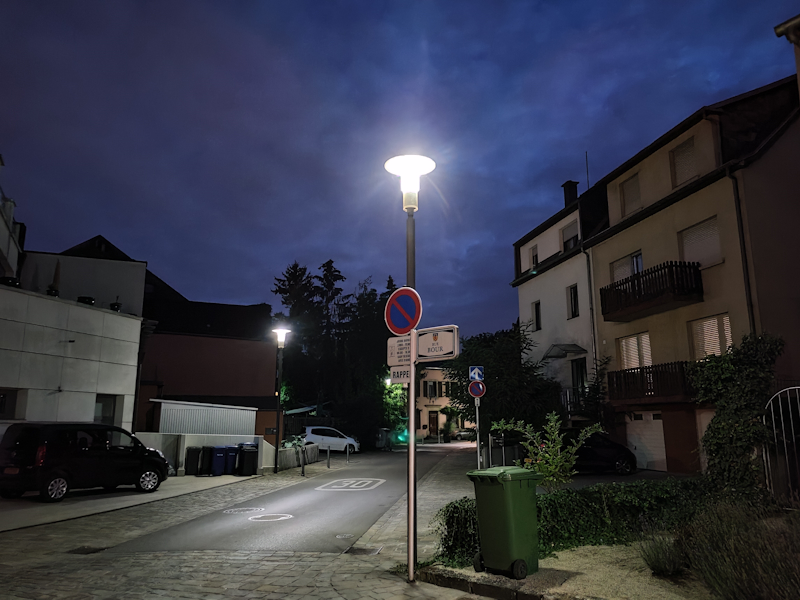
[ ROG Phone III ]
[ iPhone 11 Pro ] - [ Galaxy S20+(E) ]
[ Pixel 4 ] - [ X-T30 ]
I did like the ROG3’s exposure here as it was the most realistic of the bunch, however it lacked the higher dynamic range in the shadows of other phones.

[ ROG Phone III ]
[ iPhone 11 Pro ] - [ Galaxy S20+(E) ]
[ Pixel 4 ] - [ X-T30 ]
In brighter scenes, the ROG3 does ok, but the lack of OIS shows in the lack of detail, and the shot just has worse dynamic range than the competition, although it remains quite usable.

[ ROG Phone III ]
[ iPhone 11 Pro ] - [ Galaxy S20+(E) ]
[ Pixel 4 ] - [ X-T30 ]
Surprisingly enough this scene was to the liking of the ASUS as it produced an excellent result that although it a bit bright, has tone of good retention of textures and detail and is quite ahead of all other mobile phones.

[ ROG Phone III ]
[ iPhone 11 Pro ] - [ Galaxy S20+(E) ]
[ Pixel 4 ] - [ X-T30 ]
The darker the scene, the worse the ROG3 fares as its shutter speed can’t go as low as other phones. The S20 is able to get double the amount of light at 1/8th a second over 1/20th of the ASUS, and the iPhone ½ second exposure really shines.
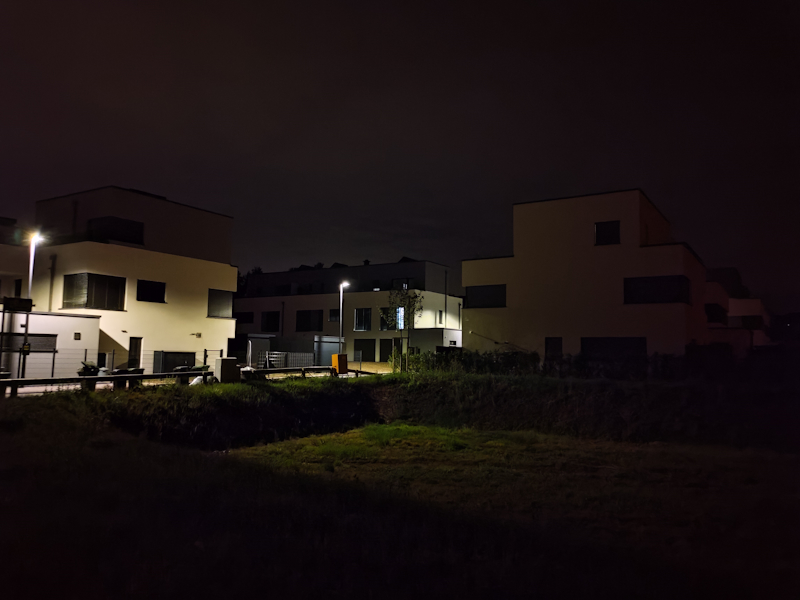
[ ROG Phone III ]
[ iPhone 11 Pro ] - [ Galaxy S20+(E) ]
[ Pixel 4 ] - [ X-T30 ]
And in the last shot again, the much slower shutter speeds of the ROG3 mean that it captures a lot less light than the competition.
Overall Low-Light Evaluation: Meh
Generally, the ROG Phone III just suffers greatly from the lack of OIS. Although its night mode seems to perform quite adequately and be competitive in terms of computational photography, the fact that its shutter speeds are always around four times faster than the competition means that it’s only able to capture about a quarter of the light. It’s very clearly a tier below other flagship devices, and generally not competitive.
Video Recording
Video recording on the ROG Phone III is interesting because it’s one of the newer phones which promise 8K recording capabilities. As the phone lacks OIS, it’ll be also interesting to see how the EIS is able to stabilise the video recording and how it holds up against the competition.
Starting off with 4K30 recording, the stabilisation employed by the phone is actually significantly better than I had expected and is able to produce an excellent result even without OIS.
4K30 on the ultra-wide gives a much better field of view and giving the EIS a better frame to be able to stabilise the video in, however the quality of the video isn’t too great as it’s lacking dynamic range – with the processing flattening highlights quite a lot.
4K60 is reserved just for the main camera, and the footage is very good, although again it’s visible how the HDR isn’t the best as we’re seeing highlights clip in and out. Overall, however, it offers excellent amounts of detail and smoothness.
8K30 is also limited to the main camera. Again, dynamic range is a weakness, however it’s one of the modes that allows for almost no quality loss when digitally zooming in. Notice the video noise when zoomed in in the video sample. The biggest issue I have with this mode is that it’s still pretty much a gimmick and not viable for every-day usage as bitrates come in at 105Mb/s and result in about 800MB of storage consumption per minute, and the phone does not have expandable storage.
Audio Evaluation
I’ve moved offices so I don’t have the same audio measurement setup to be able to showcase apples to apples measurement data, so I’ll keep my evaluation of the speakers on the ROG3 brief.
The stereo speakers of the phone are augmented by a speaker calibration by Dirac, allowing the phone to achieve actually quite impressive sound quality. The phone has quite deep bass, and the stereo balance of the two speakers is perfect given that we’re seen two identical driver setups.
Virtualisation of sound isn’t quite as good as some other devices out there, however the ROG Phone III makes up with a flatter sounding frequency response curve. It has better audio playback than Apple and Samsung devices, and edges out the Xiaomi Mi 10 Pro as well as the device with the phone with the best audio playback on the market right now.
It’s just a pity the company had dropped the 3.5mm headphone jack – it would have otherwise been a complete winner in the audio department.
Conclusion & End Remarks
The ROG Phone III is a device that attempts to carve itself out a niche place in the mobile device market. We’ve put the device through quite a lot of testing, and the question which remains is whether it’s been able to successfully rationalise its existence as a gaming device.
From a design standpoint, I think the ROG Phone III is a success, simply from a practicality point of view. ASUS doesn’t attempt to create a super-modern or sleek design, but rather what they did is to create an extremely solid phone that mostly doesn’t have any gimmicks in order to set itself as a good gaming device.
Key aspects here are simply its large size and display, the avoidance of any front notches or hole-punch cameras, and the symmetrical outstandingly well performing front-facing stereo speaker setup.
Sure, it’s a big and heavy phone, but unlike some other phones in the market, I the ROG Phone III feels more like it’s meant to be big and heavy.
The screen is a key feature of the phone, and it’s very good. Although in 2020 it doesn’t stand out quite as much as it did in 2019, the 144Hz refresh rate is still very good and the 270Hz touch response certainly helps with the fluidity of the device. ASUS also has accurate display colours, although the higher gamma target means you’ll have darker tones.
Due to its massive 6000mAh battery, the ROG3 again takes the top spot in our battery charts, beating any other flagship class device on the market, you’d actually have to give up performance to be able to get a phone with bigger batteries or longer battery life.
On the camera side of things, the situation isn’t as great. The ROG Phone III is pretty much lacklustre here, as the daylight processing just isn’t very good, with the phone having issues with exposure and HDR. In low-light, the lack of OIS is the phone’s Achilles’ heel and also isn’t able to compete much against other devices on the market. It’s by far the device’s biggest weak-point, much alike last year’s ROG Phone II.
Performance is the big question mark for the ROG Phone III, and here things are both positive and negative. It’s an extremely snappy and fluid device thanks to the 144Hz, but it does lose out on the software side of things in terms of optimisations. Running the phone in X-mode all the time gives you better performance but comes at a cost of battery life, ASUS here could have just used a smarter way to tune things rather than employing a relatively dumb minimum frequency peg.
Gaming performance is supposed to be the phone’s key selling point, and ASUS makes available a lot of features to achieve a better experience. The phone’s air trigger buttons are clear hardware advantages that cannot be copied by any other “regular” smartphone, so that’s one aspect of mobile gaming where the ROG3 takes the lead.
However, the Snapdragon 865+ seems to be a double-edged sword. While yes, it does improve peak performance by 10% over the regular Snapdragon 865 devices out there, it looks like this comes at a 25% power penalty. In sustained performance tests, the ROG Phone III without the AeroCooler add-on performs worse than competing devices from LG, OnePlus or Xiaomi. With the accessory connected, it’s only able to marginally edge out these devices, which makes you wonder if it’s all even worth it.
One positive of ASUS’s ROG Phone III SKU offering is that the base “Strix” model features just the regular Snapdragon 865, which if it performs similarly to other devices in the market, shouldn’t have the same compromises between performance and heat. ASUS also gives you the option to tune-down the phone for better thermals, but then again, what’s the point in getting it?
I don’t see the 999€ or 1099€ variants of the ROG Phone III being worth it, however the 799€ base model should make for a quite balanced phone which shines in terms of battery life, and gives you a great high-refresh rate experience. If you can live with the weak cameras, then it should represent a good phone for you.

